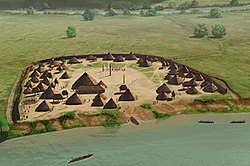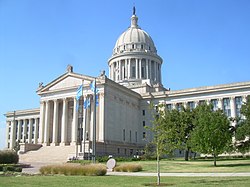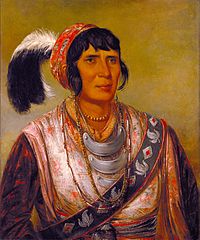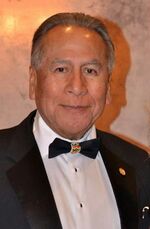Utamucanee
This article is incomplete because it is pending further input from participants, or it is a work-in-progress by one author. Please comment on this article's talk page to share your input, comments and questions. Note: To contribute to this article, you may need to seek help from the author(s) of this page. |
Chiefdom of Utamucanee Almannic: Ötamukes Häuptlingreich Utamuc: Otvlukko-Utamvkanee | |
|---|---|
| Capital and | Calusa |
| Official languages | Utamuc Ostovanitsches |
| Recognised regional languages | Sebeno Masgo Latoa |
| Demonym(s) | Utamucanean |
| Government | Unitary Parliamentary Constitutional Monarchy |
| Yaholo II | |
| Edgar Hitchitimico | |
| Legislature | National Diet |
| Establishment | |
• Settlement by Indigenous Vestric Peoples | 1100s-1500s CE |
• Colonization by Leiden | Early 1500s |
• Onderkoninkrijk of Ötamukland (Part of Onderkoninkrijk of Vestrim) | 1632 |
• First Chiefdom | 1824 |
• State of Ötamukland (Part of Ovandera) | 1878 |
• Second Chiefdom | 1922 |
• Port Herissee Constitution | 1991 |
| Area | |
• Total | 604,527 km2 (233,409 sq mi) |
• Water (%) | 3.2 |
| Population | |
• 2018 estimate | 18,796,438 |
• 2010 census | 17,268,651 |
• Density | 30.219/km2 (78.3/sq mi) |
| GDP (PPP) | 2017 estimate |
• Total | $173.87 Billion |
• Per capita | $19,766 |
| GDP (nominal) | 2017 estimate |
• Total | $157.3 Billion |
• Per capita | $17,882 |
| Gini (2016) | medium |
| HDI (2015) | medium |
| Currency | Hurpe (28.37 UMĦ = 1 US$) (UMĦ) |
| Time zone | UTC-8:00 (Calusa Time) |
• Summer (DST) | -9:00 |
The Chiefdom of Utamucanee (Leidenese: Ötamukes Häuptlingreich, Utamuc: Sokvklukko-Utamvkanee) is a constitutional monarchy in Central Vestrim, the only indigenous New World monarchy to survive Asuran Colonization. It is neighbored to the South by Ovandera, to the west by Kestvala, and to the north by the UVSS. Its closest maritime neighbor in the Columbian Sea is the Koningsland Territory of Leiden, near the Chatot Islands, the only area claimed by the Republic outside the Vestric Mainland. It is divided into 23 Governorates and two autonomous cities, New Braubach and Calusa, the second of which is the nation's capital city, which has been designated as such since 1973 after moving from New Braubach.
Utamucanee is remarkable among Vestric nations for being defined almost completely by native peoples, having never been entirely colonized by Asurans during the Age of Exploration due to numerous uprisings throughout the years. The precursors to the Utamuc and other tribes which call the nation home arrived in the area near the beginning of the 1100s CE, with evidence of earlier cultures present near the nation's coastlines and major rivers, including evidence of a major pre-Utamuc settlement outside the nation's capital, leading many in various fields to believe that it is the oldest continuously-occupied settlement in Vestrim. Leidenese Veroveraars entered the region from modern-day Ovandera in the early 16th Century, led to the Utamuc Confederacy by tribes attempting to dismantle the Latoa Empire, an aggressive coalition of native city-states near the modern border between the two countries. After establishing the Treaty of Calusa in 1515, which granted settlement rights on the Coasts and safe passage for Alydian Missionaries, the Utamuc worked with the Veroveraars to defeat their perennial enemy. During this time, they also learned the essentials of horsemanship from the Leidenese, a skill which would inexorably alter Utamuc culture, as well as make them a dangerous and highly mobile combatant for centuries to come. Following the defeat of the Latoa, it slowly became apparent that subsequent generations of colonists would not follow the agreements made by their ancestors, leading to the Cupkekunu Wars, which raged from 1632 until 1824, when the First Asuran-recognized Free Utamuc Kingdom was established alongside newly-liberated Ovandera.
Etymology
The origin of the modern term "Utamucanee", translated from the Utamuc word "Utamvkanee", is unknown to modern scholars, though local oral traditions suggest origins with a quasi-legendary founding figure. Otvmekko, roughly translated as Chief Horse Chestnut, was one of the Principal Chiefs of what was then referred to as the Cupkekunu Confederation. A historically-recognized Otvmekko did exist during the early period of Asuran Colonization in modern Utamucanee, as denoted by mentions of an "Ota Meko", a friendly native chief who met with the Veroveraars during their campaign the Latoa, further referring to the whole of the Cupkekunu culture as "Ota Meko's people" - translated back into the native language as "Otvmekko Anee", later simplified to the modern form "Utamvkanee" as indigenous peoples sought to forge a more cohesive identity between the tribes to rally behind against their oppressors. Due to Otvmekko's role in the nation's foundational legends, many politicans, especially in the earlier years of the Chiefdom, have attempted to make clear lines of descent from this figure.
History
- Main Article: History of Utamucanee
Pre-Colonial Era

Prior to the arrival of Asuran Colonists, the landscape of modern-day Utamucanee was divided between the Utamuc Confederation, for which the modern nation gets its name, who primarily resided in the south and central portions of the Cupkekunu Plateau. This confederation was composed of the Masgo, who primarily lived in the northern regions of the High Plateau and parts of the Fakusulke regions, and Sebeno peoples, which settled the coastal areas near modern-day New Braubach. In the area which today composes the border between Ovandera and Utamucanee, a group of tribes called the Latoa began expanding northward, conquering many settlements in the formation of a rapidly-expanding early empire. It is estimated that Latoa conquests had taken place over the bulk of the 13th through the early 15th Centuries, spurring the formation of the Utamuc Confederation and shift towards a more completely agrarian and complex society. By the 16th Century, the Latoa had become a military powerhouse in the region thanks to both their advanced agricultural complex, which permitted them the ability to support a large population, as well as access to obsidian for use in weaponry. The development of the Utamuc Confederacy allowed for the largely plains-dwelling peoples to achieve access to timber supplies from their western allies, as well as other building materials and larger amounts of coordinated manpower to build the necessary fortifications to fend off Latoa attacks. This period of Pre-Colonial Utamuc history allowed for the quick development of an advanced warrior culture from pre-existing traditions, as well as development of both sophisticated spear-fighting and bow tactics. While largely successful in keeping Latoa aggression south of the Confederacy's de facto Capital of Calusa, by the early 16th Century, the remaining Latoa in the region had grown much more entrenched and brazen in their attacks, slowly choking off their supply lines and alliances.

It was at this moment that the first wild horses began appearing in the southeastern portions of the nation, specifically in the Utamuc-controlled parts of the Cupkekunu, which are believed to have been accidentally released during Leidenese explorations further south and into Ovandera. While the first known attempts at developing a true culture of horsemanship was not immediately achieved, this animal was seen at the time to be a great blessing to the Utamuc as a much-needed food source for the pastoral tribes who saw their flocks sacked by Latoa invaders. Thanks to this, husbandry of these animals were quickly adopted, and knowledge of the "miracle beasts" spread quickly through the Confederacy.
Early Colonization
The first Asurans to enter modern Utamucanee were the Leidenese in 1513, at the site of modern-day New Braubach, which was subsequently founded in 1521. This site would become the core settlement of the Onderkoninkrijk of Ötamukland and one of the primary foci of Leidenese Colonization on the Vestric Mainland.
Onderkoninkrijk of Ötamukland (Early 17th Century-1810s)
First Chiefdom (1824-1878)
Ovanderan Ötamukland (1878-1922)
Second Chiefdom (1922-Present)
Early Years (1920s-1930s)
De Miskin-Soolesulka and the Mid-20th-Century
Pachilusa's Chiefdom (1981-2002)
Current Events
Geography
The geography of Utamucanee is divided into four distinct regions. The lowest and most populous areas near the coast, characterized by extremely fertile and vast plains, are the la'aganatka and la'aganlusi, which are sometime considered as a single set of regions called the la'agans thanks to their many similarities. There are also the cupkekunu, the Utamuc High Plateau, and fakusulke, the heavily forested region of the Far Northwest which holds the nation's only true mountains.
Climate
Biodiversity
Government and Politics
- Main Article: Politics of Utamucanee

Since 1995, Utamucanee has been arranged as a Constitutional Monarchy. The High Chief (Lukkonopy) largely acts as a ceremonial figurehead and head of state, while most regular executive power is held by the head of government, the Chancellor of the Diet. The High Chief has the powers to grant pardons, form governments, and provide the royal assent. While most executive powers are ceded to the Chancellor, the High Chief still occasionally intervenes in Utamuc politics, as is permitted in the Constitution. Chiefly Privilege is usually invoked in cases of causes celebre which face intense, long-term parliamentary gridlock, though incidents of this have become increasingly rare over the years.
From the founding of the Second Chiefdom up until 1995, Utamucanee was an absolute monarchy. Starting in the late 1980s, High Chief Pachilusa Malatche engaged in numerous reform processes, ceding numerous executive powers to the Chancellor and to Parliament. Despite these significant democratizations, the Chief's place in Utamuc society is considered sacrosanct. As such, lèse majesté remains a criminal offense in some cases, though its severity in terms of punishment has been reduced significantly following the adoption of the 1991 Constitution and further pressure from members of the Vestric Forum in following years.
Chancellorship and Council of Elders
- Main Articles: Chancellor of Utamucanee, Council of Elders

The Chancellor, or Reikschappawa is the head of government of Utamucanee, and exercises chief executive powers through the Council of Elders, or Reikstimpanak, their executive cabinet. The Chancellor is elected by and responsible to the National Diet. The members of the Council of Elders are also elected by the Diet and approved by the Chancellor. A number of additional offices have been formed outside those mandated by the constitution, but carry similar responsibilities to other regular Council members. Unlike regular Elders, however, these offices are directly appointed by the Chancellor. All members of the Council of Elders are responsible for attending regular meetings with the Chancellor and Diet.
Since 1991, foreign affairs responsibilities are shared between the High Chief, Chancellor, and the Councilor-Ambassador, though the High Chief has generally defaulted to the Chancellor on most matters. Matters relating to national security are almost exclusively in the hands of the latter two, though trade and other relations have significantly more room for input left to the High Chief.
Legislature
- Main Article: National Diet

The unicameral National Diet of Utamucanee (Reikschakko) exercises supreme legislative authority in Utamucanee. It is organized in the manner of a parliamentary system, with the Chancellor acting in a manner similar to that of a Prime Minister. It may amend the constitution, draft ordinary laws, dismiss the Council of Elders, and override vetoes made by the Chancellor or High Chief. Its acts are subject to judicial review and assessment by the National Court. Members of the Diet are elected for six-year terms, which are renewable up to four times for a total of 24 possible years in national office. The last set of general elections took place on 17 October, 2018, and the next are set to take place in October of 2024, though snap elections may be called by the Chancellor with a majority vote of the Diet. The Chancellor acts as the head of the Diet, representing the leading government coalition. Representation within the 200-member Diet is currently arranged using the proportional D'Hondt Method utilizing open-list member districts.
A session of the Diet can be dissolved by the High Chief with reccomendation of the Chancellor, though this option has not been utilized since the adoption of the 1991 constitution. Prior to Its adoption, however, the High Chief was capable of dissolving it unilaterally, which occurred nine times between 1922 and 1990.
Administrative Divisions
- Main Article: Governorates of Utamucanee
Military
- Main Article: Utamucanee Armed Forces
Foreign Affairs
- Main Article: Foreign Affairs of Utamucanee



